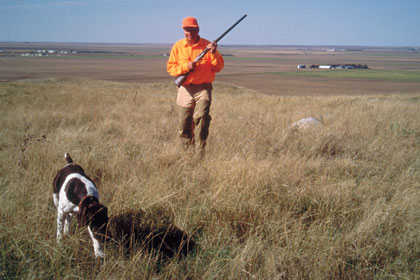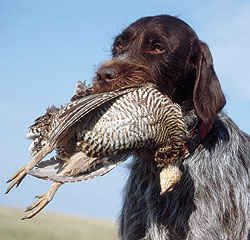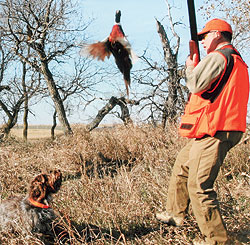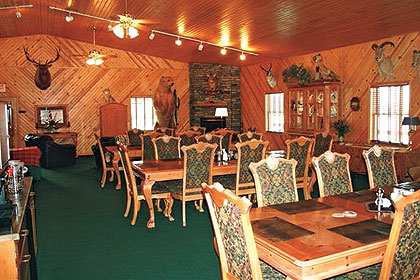A good chance for a South Dakota grand slam.
By Jerry Thoms
First-time visitors to Tumbleweed Lodge in central South Dakota are almost always impressed with the 12,000 acres of prairie landscape stretching across this region of the upper Great Plains. Just as impressive are the numbers of gamebirds on the Tumbleweed property, with pheasants roaming nearly everywhere there is any kind of cover or food sources.
 First-time visitors to Tumbleweed are almost always impressed with the wide open spaces of the prairie in this part of the upper Midwest. |
A little more elusive but still present are the sharptailed grouse, prairie chickens and Hungarian partridge found here. These birds sometimes mix with pheasants in man-made food plots and big stands of wild prairie grass. But just as often, the prairie grouse and partridge are scattered in small family groups and big flocks on the hilltops and hillsides at the far edges of the ranch land.
"Look at that big bunch of blackbirds at the end of that cornfield," a hunter from Michigan said late one afternoon last October to Michael Bollweg, owner-operator of Tumbleweed Lodge. "Uh, well, those are actually pheasants flying from a food plot to a roosting spot in the prairie grass," Bollweg explained to his somewhat embarrassed guest.
"I don't think the guy really believed me about the big cloud of pheasants until the next morning when our group of hunters walked through the prairie grass and flushed about 100 ringnecks in a half hour," Bollweg later said. "And he didn't mistake prairie grouse or partridge for any other kinds of birds that afternoon."
 Another kind of grand slam on the Tumbleweed Ranch is a combination of ringneck roosters, prairie grouse, and Canada geese later in the season from mid-November to the end of December. |
Seeing all these gamebird species at Tumbleweed is the result of the Bollweg family's commitment to managing a successfully operating cattle ranch in conjunction with an equally successful commercial hunting operation. "Bird hunting has always been a tradition with us," Bollweg says. "So the transition from the family-based hunting history to a hunting business was a natural move on our part."
Part of the transition included adding more gamebird-friendly habitat to the ranch so that nowadays, in addition to the vastness of the prairie pastures and grassy creek bottoms, there are thousands of acres of corn and sorghum fields, long tree belts, and big patches of hardwood shrubs. "Everything here is designed to produce pheasants, grouse and partridge, to protect these birds through hard winters, and to give everyone a place to hunt them from mid-September to the end of December. And because one part of our ranch property has a hunting preserve designation, we can hunt pheasants from the first of September to the end of March," Bollweg explains.
Hunting Strategies At Tumbleweed Lodge
There are several ways pheasants, prairie grouse and Hungarian partridge can be hunted at Tumbleweed Lodge. One common method is a walker-and-blocker hunt in which a large, organized group of shotgunners (up to a dozen) walk through a large food plot, a big tract of CRP, or a long tree belt. The purpose is to flush some birds up in front of the line of walkers and to push other birds to the end of the cover where blockers are waiting to shoot them. Close-working flushing dogs or well-controlled pointing dogs are usually part of the plan with the objective of putting game into the air and fetching shot birds when they hit the ground.
 Any breed of gun dog will have ample opportunity to hunt prairie grouse and ringneck pheasants on the 12,000 acres of Tumbleweed Ranch property. |
These walk-and-block hunts can be spectacular, with some cover often producing dozens, even hundreds, of pheasants, small groups of Huns, or at times, a few flocks of prairie grouse. Though there can be shotguns fired in several directions, the safety factor in these hunts is good if no low shots are taken and everyone is aware of each other's location among the walkers and blockers.
"This is the way we hunted pheasants 35 years ago when I was growing up back home in Michigan," one hunter recollected after his group of six walkers met the three blockers at the end of an 80-acre field of CRP filled with head-high prairie grass--and pheasants, lots of pheasants.
Over 100 ringnecks, more than half of them roosters, had boiled up in front of the walkers and their dogs. Any birds that didn't fall to the moving shotgunners flew at high speed over those waiting at the end of the field. There some roosters hit the ground in an explosion of feathers and others, untouched by any pellets, kept right on going.
Another hunting technique at Tumbleweed is for a few hunters (from two to five) in ATVs, SUVs, or pickups to ride to small patches of prairie grass, food plots, creek bottoms or tree belts that often hold pheasants, grouse or Hungarian partridge.
Though this may sound easy, in many cases the birds will run to the outside of the cover and flush on the edge of shotgun range. Fast, on-target shooting is necessary for a limit that might be had in a few hours or with an all-day effort. No matter what, the action is always exciting. As with other hunting methods, good dogs are key ingredients for success.
"I've hunted quail in South Carolina, Georgia, and Alabama and have had the thrill of covey rises that nearly made my heart stop. But having a half dozen ringneck pheasants, a dozen Hungarian partridge or a bunch of prairie grouse explode out of a patch of cover is an even bigger thrill in my opinion," says Ron Kline, a 72-year-old hunter from Pennsylvania. "When we walk into these small stands of sorghum, prairie grass or plum thickets, we never know what the dogs will flush until the birds are in the air. And though the shots may seem easy when we later talk about them, when we're taking them, they're not," Kline reports with a grin.
A third Tumbleweed hunting strategy is for a couple of shotgunners and their dogs to walk the more rugged draws, gullies, and ravines accessible only on foot. These are the places to which ringnecks, Huns and prairie grouse will gravitate early in the season to escape hunting pressure and later in the year to escape cold and windy
weather conditions.
 At Tumbleweed Lodge, old tree belts next to big tracts of prairie grass make the ideal location for a hunter and his gun dog to find pheasants any time during the season. |
Walking in these places might take three to five hours and cover three to five miles. The terrain is often steep with short grass, buffalo berries, and sumac bushes on the tops and sides of the hills and sometimes slough grass and maybe a few old cottonwood trees down in the creek bottoms.
"I call this my annual heart, lungs, and legs test," says Bob Scranton from Houston, Texas. "Every year for the past five seasons, one of my hunting buddies and I walk from here to that hill over there where the black angus look like pepper specks in the grass," Scranton said as he pointed to a herd of cattle probably three miles away.
"This is a long, hard walk, but we get into birds that may not see many hunters or dogs all season, maybe all year for that matter. Though the walk is tough, the shooting is always good with our setters and pointers usually finding pheasants, grouse, and Huns all along the way," Scranton adds.
What Breeds Will Do Well At Tumbleweed?
Hunters who come to Tumbleweed Lodge are welcome to bring their own dogs, with a wide variety of breeds showing up each year. Michael Bollweg has some advice for anyone who wants to use their own dog for any of the gambirds on the place.
"Try to have your dog in good shape for working hard for at least a couple hours each day for three days in a row," Bollweg says. "Early in the season, the weather can be warm, so all dogs should be conditioned for temperatures in the 60s and70s. The habitat hunted is a mix of short and tall grass, food plots with heavy vegetation, and tree belts with lots of underbrush the dogs will have to break through.
"We start in July conditioning our vizslas for our October trip to Tumbleweed," says Gordon Stahlman from Denver, Colorado. The first time Stahlman came to South Dakota, he admits his dogs weren't in shape for warm to hot weather and for long, hard hunts.
"All three of our dogs were worn out by the second day and needed a whole day to rest up for the remainder of our trip," Stahlman recalls. "Now, to get ready, we run all our dogs every morning for three miles and swim them every afternoon for 30 minutes.
Bollweg tells us our vizslas are some of the best all-day hunters he has ever seen."
"We suggest that all dogs wear an e-collar to ensure control when dozens of pheasants might run down rows of corn or sorghum or Huns and prairie grouse flush in a big flurry," Bollweg advises. "The temptation most canines here have is to chase running or flying birds. So an e-collar is a good way to keep most any dog from wrecking a hunt by flushing pheasants, Huns or grouse out of range."
E-collars for springer spaniels?
The idea was sort of a shock to Al O'Connor, a visiting hunter from Wisconsin. "We hunt ducks and ruffed grouse back home and don't always use e-collars because we have the dogs in the boat with us and can usually see them in the woods," O'Connor says. "But when we got to Tumbleweed our springers disappeared in a second when roosters started running down crop rows. The only way we knew where the dogs were was to watch for pheasants flushing 100 years ahead of us."
 The dining area of the lodge at Tumbleweed. |
O'Connor's problem was solved by using an e-collar with a remotely activated beeper. "I can stop the dogs from chasing running birds and, with the beeper, I can always tell with just the push of a button where each dog is in heavy cover," O'Connor says. "Now, more of my buddies want to hunt with us rather than to stay away from us."
Pointing breeds and flushing breeds will have plenty of opportunities to do well at Tumbleweed because there are literally thousands of acres of great bird-holding habitat on the place. Bollweg points out, "No one with any kind of gun dog has ever complained that their dogs didn't have enough cover or birds to hunt."
Shotgun and Shotshell Recommendations
Most shotgunners at Tumbleweed Lodge use 12-gauges for pheasants, Huns and prairie grouse. "We recommend 12s over 20s as the best gauge choice," Michael Bollweg says, "because the bigger gun with a wide range of ammunition choices will handle most all the shooting opportunities on all the game species here. A majority of our clients bring semi-automatics or double barrels and our loaner guns are either 12-gauge Benelli semi-automatics or Beretta over-unders.
"The recommended ammunition for all the gamebirds is a high velocity 1,400 to 1,500 feet per second load with 1¼ ounce of #5s or #6s early in the season and #4s or #5s for later in the year. Experienced hunters usually bring premium ammo by Federal, Winchester, Remington, Fiocchi, or Kent. Or we can supply these same shells for our guests who don't want to carry ammunition when flying on commercial airlines," Bollweg adds.
What Level of Hunting Experience Is Necessary At Tumbleweed?
Bollweg often receives phone calls or emails from prospective clients concerned about the degree of difficulty involved in hunting gambirds at Tumbleweed. "We assure everyone who asks that we can offer a good hunting experience to nearly anyone of every age, physical ability, or hunting background. This includes first-time hunters who may need an introduction to shotguns, gamebirds, and gun dogs as well as old time veteran hunters who just want some good chances to do what they have done over a whole lifetime," Bollweg says.
"We design hunts to fit the individual and don't put together a one-size-fits-all hunting experience. Our guides are good at recognizing the needs of our clients," Bollweg emphasizes.
"The first time we came to Tumbleweed, I had my two teenage boys on their first hunting trip away from home where they had shot some cottontail rabbits and mourning doves," says Doug McNeeley from Atlanta, Georgia. "Also along were my two older brothers who had been all over the United States hunting all kinds of gamebirds.
 The sleeping quarters are nice and roomy so tired hunters can relax comfortably before their next adventure. |
"The Bollwegs spent
time with my kids on the sporting clays range, took them out alone to shoot some pheasants over their Labradors, then made sure the kids had some good shots at Hungarian partridge the next day.
"My two brothers and I spent a morning on a five-mile walk for prairie grouse one day while my sons went with Michael Bollweg to hunt some food plots for ringnecks all afternoon," McNeeley recalls. "The next two days we all hunted together for pheasant, Huns and grouse with my two kids outshooting us old guys a couple of times."
The Tumbleweed Grand Slam
The "grand slam" on gamebirds at Tumbleweed Lodge can actually include a couple possibilities. One is a combination of ringneck rooster pheasants and Hungarian partridge (the obviously easier part) with sharptail grouse and prairie chickens (the more difficult but still do-able task). Because pheasants and Huns hang out in or close to food plots and grassy pastures, finding and harvesting them in the same place is almost always a matter of a few days' hunting. Locating and shooting prairie grouse, however, can take more time and sometimes more effort because they be be scattered across more territory in the 12,000 acres of land at Tumbleweed.
There is another kind of grand slam, however. Though much of the hunting at Tumbleweed takes place from late September to early November, the period from mid-November to the end of December can be a good time for combining pheasants, Huns, and grouse with a trip a few miles to the west of the ranch for geese on the Missouri River Reservoirs. "Lake Oahe, in particular, can hold thousands of Canada honkers, white fronts, and even snows and blues, usually beginning in the middle of November and extending into December," says Michael Bollweg.
Although South Dakota waterfowl licenses for non-residents are limited to a certain prescribed number chosen in a lottery system in June, there are six counties along the Oahe Reservoir, north of Pierre, where non-residents can purchase licenses over-the-counter at any time during the waterfowl season.
"Every year clients come to Tumbleweed early to hunt pheasants, Huns and grouse, then come back later to add a waterfowl hunt to this gamebird combination.
"Those who come in the November-December period are often interested in harvesting the older mature trophy upland birds and then shooting a cross-section of goose species including Canadas, specklebellies and snows and blues," Bollweg says.
Conclusion
A trip to Tumbleweed Lodge will not guarantee a grand slam on gamebirds. But any hunters here can be assured that the opportunity for a combination of ringneck roosters, prairie grouse, or Hungarian partridge is very possible, and adding waterfowl to the mix may make the challenge even greater.
Hunting any or all of these gamebirds can make for the trip of a lifetime. For more information, see the lodge's website: www.tumbleweedlodge.com; or call (605) 875-3440.






